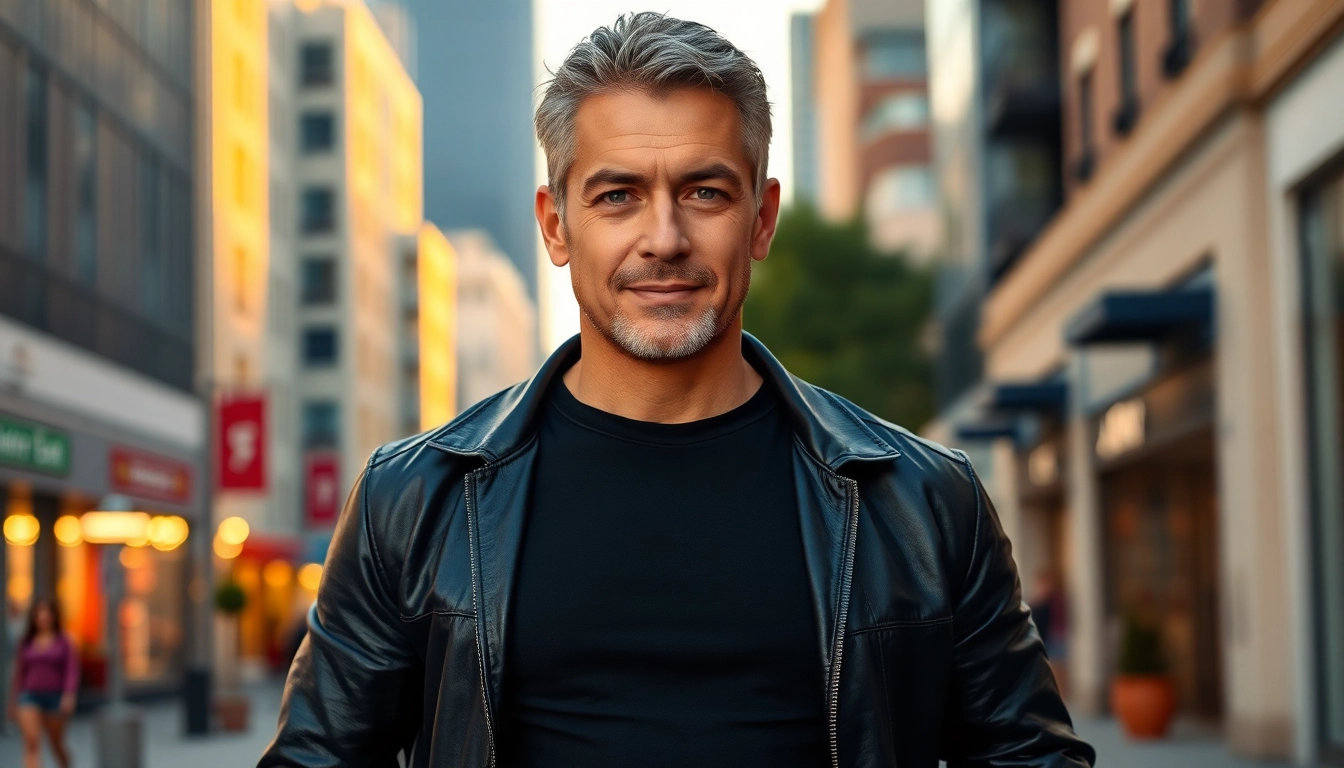Introduction: What is a DILF? Origin and Definition
The term dilf is a colloquial acronym that stands for “Dad/Daddy I’d Like to Fk.” Originally emerging from internet slang and pop culture, it has become a widely recognized descriptor for a particular archetype of attractive, mature men who exude masculinity, confidence, and appeal. Unlike the initial assumption that a DILF must be an actual father, the term broadly applies to older men who embody the qualities associated with attractiveness and sexual desirability, regardless of their parental status. The phrase gained popularity shortly after the similar term MILF, which refers to “Mom I’d Like to Fk,” and has since become a staple in both casual conversations and cultural references. Its usage can be humorous, flirtatious, or even admiring, often employed to compliment a man’s appearance or charisma. The concept taps into societal ideals of masculinity, maturity, and rugged attractiveness, making the archetype both relatable and aspirational in modern culture.
Cultural Significance: How DILFs Have Entered Popular Culture
The emergence of the dilf term reflects broader cultural trends that celebrate masculinity, maturity, and the allure of older men. Over the past two decades, DILFs have become a recurring motif across various media, social platforms, and entertainment genres. This shift signifies a fascination with aging gracefully while maintaining an attractive and desirable persona. The archetype often symbolizes stability, confidence, and life experience—traits that many find appealing in a partner or a character.
Furthermore, the rise of social media and internet culture has amplified the visibility of DILFs, turning them into icons of attractiveness and humor. The term has evolved from being a simple slang expression to a cultural phenomenon that encompasses a wide spectrum of representations, from fictional characters to real-life personalities. Its popularity also underscores changing attitudes toward masculinity, where age and experience are increasingly celebrated rather than diminished. The DILF archetype continues to influence fashion, advertising, and entertainment, reinforcing its role as a symbol of mature allure.
Famous DILF Characters in Movies and TV Shows
Daddy Halsin from Baldur’s Gate
One of the most iconic figures associated with the DILF archetype in recent pop culture is Daddy Halsin, a character from the popular role-playing video game Baldur’s Gate. Halsin is portrayed as a strong, protective, and wise druid with a commanding presence. Fans of the game have affectionately dubbed him “Daddy Halsin” due to his masculine appearance, leadership qualities, and nurturing personality. This character embodies the traits that define a DILF: mature confidence, strength, and a caring demeanor, making him a favorite among players who appreciate a blend of power and tenderness.
Fred Andrews from Riverdale
In the realm of television, Fred Andrews, played by Luke Perry in the teen drama series Riverdale, is frequently cited as a quintessential DILF. His character is depicted as a dedicated father, a hardworking small-town businessman, and a handsome, mature man who exudes charm and stability. Fans often describe Fred as the ideal blend of rugged masculinity and genuine kindness, qualities that resonate with the DILF archetype. His portrayal underscores how attractiveness in older men can be rooted not just in appearance but also in personality and life experience.
Rob’s Father in American Pie Presents: The Book of Love
The 2009 movie American Pie Presents: The Book of Love introduces Rob’s father, a character who exemplifies the DILF image in a comedic context. His portrayal plays on the humor associated with older, attractive men who are still desirable, often leading to humorous situations that highlight the character’s charm and attractiveness. This film helped cement the DILF as a recognizable figure in comedy and pop culture, emphasizing that age and attractiveness can go hand-in-hand in a humorous light.
DILFs in Internet Culture and Social Media
DILFs of Disneyland Instagram Account
One of the most prominent modern manifestations of DILF culture is the DILFs of Disneyland Instagram account. With over 300,000 followers, this account shares photos of fathers and older men enjoying family days at Disneyland, celebrating their attractiveness and the joy of fatherhood. The account combines humor, admiration, and a sense of community, emphasizing that DILFs are not just fictional characters but real men who embody the qualities of this archetype. It also challenges traditional notions of masculinity by showcasing men of various ages, backgrounds, and appearances, all appreciated for their charm and presence.
r/DILFs Reddit Community
The online community r/DILFs on Reddit is another testament to the term’s cultural penetration. With nearly 100,000 members, this NSFW subreddit serves as a space for sharing images, videos, and discussions centered around attractive older men. The community blends humor, admiration, and sexual appreciation, reflecting how internet culture embraces and popularizes the DILF concept. This digital space underscores the evolving perception of masculinity, where age and maturity are celebrated as desirable qualities rather than limitations.
The Evolution of the Term DILF in Pornography and Search Trends
The term dilf has experienced significant growth in popularity within adult entertainment and online search behavior. As the term entered mainstream vernacular, it quickly became a popular tag in pornography, helping consumers find content featuring older, attractive men who fit the archetype. This trend reflects a broader acceptance and desire for diverse representations of masculinity in erotic media.
Search engine data indicates a steady increase in queries related to DILFs over recent years, paralleling the rise of social media pages and online communities dedicated to celebrating this archetype. The popularity of DILF content also signifies a shift in societal attitudes—where age is no longer a barrier to attractiveness or sexual desirability, but rather a feature that enhances allure. This evolution illustrates how cultural and digital trends influence perceptions of masculinity and sexuality.
The Attractiveness and Characteristics of a DILF
What makes a man a DILF? While physical appearance plays a significant role, the archetype encompasses a range of qualities that contribute to overall attractiveness. Typically, DILFs are characterized by:
- Maturity and Confidence: They exude self-assurance and comfort in their own skin, often having a calm, commanding presence.
- Physical Traits: These may include a fit or muscular build, signs of aging such as graying hair or subtle wrinkles, and a masculine aura.
- Personality and Charisma: Charisma, humor, kindness, and life experience add to their appeal, making them attractive beyond just looks.
- Style and Grooming: Well-maintained grooming, fashion sense, and a sense of personal style elevate their attractiveness.
- Protective and Nurturing Qualities: Traits like protectiveness, reliability, and emotional maturity often endear DILFs to others, emphasizing their role as both desirable and dependable.
In essence, a DILF combines physical appeal with the qualities of a mature, confident, and emotionally stable individual, making them highly desirable in various contexts.
Humor and Seriousness: How the Term Is Used in Various Contexts
The usage of dilf spans a spectrum from humorous banter to genuine admiration. In casual conversations, it might be employed humorously or teasingly among friends, often as a compliment to an attractive older man. For instance, someone might joke about a handsome father at a family gathering, calling him a DILF as a playful nod to his attractiveness.
In more serious or admiring contexts, the term is used to genuinely appreciate a man’s appeal and charisma, sometimes as part of romantic or flirtatious exchanges. Its versatility allows it to be both lighthearted and respectful, depending on the tone and intent of the speaker.
Popular media, memes, and online communities have further cemented its place as a cultural shorthand for expressing attraction to mature masculinity. The term’s humor often lies in its boldness and the playful recognition of societal norms around age and attractiveness, making it a dynamic part of contemporary slang.
Conclusion: Why the DILF Archetype Continues to Captivate Audiences / The Ultimate Guide to DILFs: Exploring the Charm and Culture Behind the Term
The archetype of the dilf continues to resonate across various facets of culture, media, and internet communities. Its appeal lies in the celebration of maturity, confidence, and masculinity—traits that are increasingly appreciated in modern society. Whether portrayed in movies, TV shows, or social media, DILFs embody an aspirational blend of strength, experience, and charm that transcends generations.
As cultural attitudes evolve, so does the perception of attractiveness. The DILF archetype challenges traditional notions that youth is synonymous with beauty, instead emphasizing that age can be an asset in desirability. This shift not only broadens the definition of attractiveness but also promotes a more inclusive appreciation of masculinity.
In the digital age, communities like r/DILFs and Instagram accounts dedicated to celebrating DILFs foster a sense of belonging and admiration. These platforms highlight that attractiveness is diverse and multifaceted, encompassing personality, charisma, and style alongside physical traits.
Ultimately, the enduring popularity of the dilf archetype reflects society’s ongoing fascination with mature masculinity and the universal appeal of confident, attractive men who embody life experience and strength. Whether as a humorous term or a genuine compliment, DILFs continue to captivate audiences and shape conversations around attractiveness and gender roles in contemporary culture.

